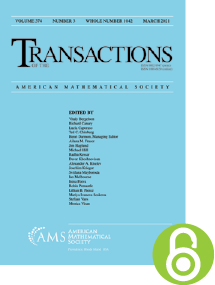Chebyshev-type cubature formulas for doubling weighted spheres, balls, and simplexes
HTML articles powered by AMS MathViewer
- by Feng Dai and Han Feng PDF
- Trans. Amer. Math. Soc. 372 (2019), 7425-7460 Request permission
Abstract:
This paper shows that, given a doubling weight $w$ on the unit sphere $\mathbb {S}^{d-1}$ of $\mathbb {R}^d$, there exists a positive constant $K_{w,d}$ such that, for each positive integer $n$ and each integer $N\ge \max _{x\in {\mathbb {S}^{d-1}}} \frac {K_{w,d}} {w(B(x, n^{-1}))}$, there exists a set of $N$ distinct nodes $z_1$, …, $z_N$ on $\mathbb {S}^{d-1}$ for which \begin{equation} \tag {$\ast $} \frac {1}{w({\mathbb {S}^{d-1}})} \int _{{\mathbb {S}^{d-1}}} f(x) w(x)\, d\sigma _d(x)=\frac 1N \sum _{j=1}^N f(z_j),\qquad \forall f\in \Pi _n^d, \end{equation} where $d\sigma _d$, $B(x,r)$, and $\Pi _n^d$ denote the surface Lebesgue measure on ${\mathbb {S}^{d-1}}$, the spherical cap with center $x\in \mathbb {S}^{d-1}$ and radius $r>0$, and the space of all spherical polynomials of degree at most $n$ on ${\mathbb {S}^{d-1}}$, respectively, and $w(E)=\int _E w(x) \, d\sigma _d(x)$ for $E\subset {\mathbb {S}^{d-1}}$. If, in addition, $w\in L^\infty ({\mathbb {S}^{d-1}})$, then the above set of nodes can be chosen to be well separated: \[ \min _{1\leq i\neq j\leq N}\arccos (z_i\cdot z_j)\geq c_{w,d} N^{-\frac 1{d-1}}>0.\] It is further proved that the minimal number of nodes $\mathcal {N}_{n} (wd\sigma _d)$ required in ($\ast$) for a doubling weight $w$ on ${\mathbb {S}^{d-1}}$ satisfies \[ \mathcal {N}_n (wd\sigma _d) \sim \max _{x\in {\mathbb {S}^{d-1}}} \frac 1 {w(B(x, n^{-1}))},\qquad n=1,2,\ldots .\] Proofs of these results rely on new convex partitions of ${\mathbb {S}^{d-1}}$ that are regular with respect to a given weight $w$ and integer $N$. Similar results are also established on the unit ball and the standard simplex of $\mathbb {R}^d$.
Our results extend the recent results of Bondarenko, Radchenko, and Viazovska on spherical designs.
References
Additional Information
- Feng Dai
- Affiliation: Department of Mathematical and Statistical Sciences, University of Alberta, Edmonton, Alberta T6G 2G1, Canada
- MR Author ID: 660750
- Email: fdai@ualberta.ca
- Han Feng
- Affiliation: Department of Mathematics, City University of Hong Kong, Kowloon, Hong Kong, People’s Republic of China
- MR Author ID: 997105
- Email: hanfeng@cityu.edu.hk
- Received by editor(s): June 13, 2017
- Received by editor(s) in revised form: July 12, 2017, and May 23, 2019
- Published electronically: August 28, 2019
- Additional Notes: This work was supported by NSERC Canada under grant RGPIN 04702.
- © Copyright 2019 American Mathematical Society
- Journal: Trans. Amer. Math. Soc. 372 (2019), 7425-7460
- MSC (2010): Primary 41A55, 65D32; Secondary 41A63, 52C17, 52C99
- DOI: https://doi.org/10.1090/tran/7924
- MathSciNet review: 4024557


